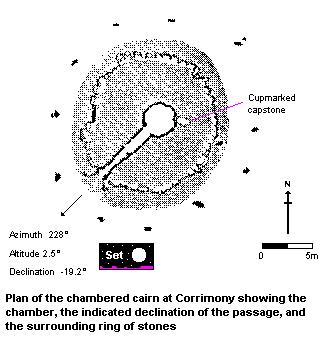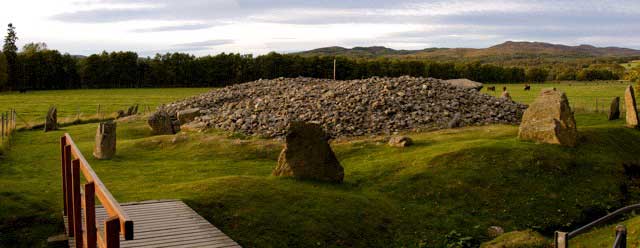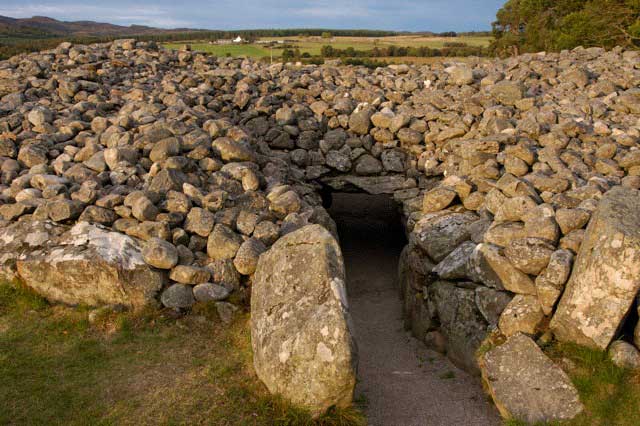
Corrimony, Inverness-shire
Stones
of Wonder
QUICK LINKS ...
HOME PAGE
INTRODUCTION
WATCHING
THE SUN, MOON AND STARS
THE
MONUMENTS
THE
PEOPLE AND THE SKY
BACKGROUND
ARCHAEOASTRONOMY
USING
THE SITE DESCRIPTION PAGES
VISITING
THE SITES
THE
LEY LINE MYSTERY
THE
SITES
ARGYLL
AND ARRAN
MID
AND SOUTH SCOTLAND
NORTH
AND NORTH-EAST SCOTLAND
WESTERN
ISLES AND MULL
Data
DATES
OF EQUINOXES AND SOLSTICES, 1997 to 2030 AD
DATES
OF MIDSUMMER AND MIDWINTER FULL MOONS, 1997 to 2030 AD
POSTSCRIPT
Individual
Site References
Bibliography
Links
to other relevant pages
Contact
me at : rpollock456@gmail.com
Chambered Cairn NH383303*
How to find : Take the A831 through Glen Urquhart. The site is signposted on a minor road 7km east of Cannich. Corrimony chambered cairn is in state care, with a car parking area available just before you reach the site.
Best time of year to visit : The passage of the cairn is aligned on the moon at its southern minor standstill, which occurs every 18.6 years. (see dates). This cairn is the best preserved of the Clava type and is well worth visiting at any time.
 As
one of the small group of Clava type monuments (see Clava site itself),
Corrimony has the usual ring of stones surrounding a cairn, which is revetted
by a ring of kerbstones. A straight passage which uniquely has part of
its roofing still in place leads into a circular central chamber, 3.5
metres in diameter, now open to the sky. Above the large basal blocks
inside the chamber the walling rises in rough drystone, with about 12
surviving courses of oversailing stones. This technique of roofing a vault
is called corbelling. A massive cupmarked slab, which is likely to have
completed the roof of the chamber, now lies to one side on top of the
cairn.
As
one of the small group of Clava type monuments (see Clava site itself),
Corrimony has the usual ring of stones surrounding a cairn, which is revetted
by a ring of kerbstones. A straight passage which uniquely has part of
its roofing still in place leads into a circular central chamber, 3.5
metres in diameter, now open to the sky. Above the large basal blocks
inside the chamber the walling rises in rough drystone, with about 12
surviving courses of oversailing stones. This technique of roofing a vault
is called corbelling. A massive cupmarked slab, which is likely to have
completed the roof of the chamber, now lies to one side on top of the
cairn.
An excavation in 1952 showed that the chamber had been broken into, probably by treasure-hunters, in the 19th century, but fortunately the original floor layers remained intact.¹
Below an area of flat slabs in the centre of the sand floor was found evidence of a single crouched burial. The body had dissolved away in the acidic conditions, leaving only a dark stain. The head of the burial had been laid to face down the passage. No artefacts were found during the excavation except for a bone pin on the floor of the passage.
At present there are eleven stones in a circle surrounding the cairn, but the original number and arrangement of stones is not certain.
Four of the stones have been added in modern times. The two stones clockwise from the entrance are composite arrangements possibly of lintel stones robbed from the passage sometime before 1874. The two stones anticlockwise from the entrance have been set up in modern times.
The orientation of the monument, as with most of the Clava group chambered cairns and ring cairns is unmistakably towards the south-west. The plan above shows the indicated azimuth for the centre of the passage as 228°, horizon altitude 2.5°, giving a declination of -19.2°.² This shows that an observer inside the monument could have watched the moon set at one of its extreme positions in the sky, often called the minor standstill. It would have been necessary to get very low on the floor to see the horizon beyond the end of the passage, as you may confirm yourself! As the passages at Clava itself are orientated towards the extreme winter setting point of the sun, the builders of these monuments must have had an interest in the extreme positions of both of the most important sky objects, for ritual or religious reasons which are now unknown. Alternatively, the passage was simply orientated in a general way towards the position of the setting sun at midwinter; or towards the setting moon in the year the cairn was put up.
Other Clava type chambered cairns with these southerly orientations include the monuments at Avielochan, Carn Daley, Dalcross, Kinchyle of Dores, Carn Urnan and Croftcroy, all of which appear to be orientated on the setting moon at the major or minor standstills.³

Corrimony cairn and stone ring

Corrimony chambered cairn entrance passage
Above photos of Corrimony courtesy William A. May MD
More photos of the cairn and the cupmarked capstone (115K) can be viewed here.